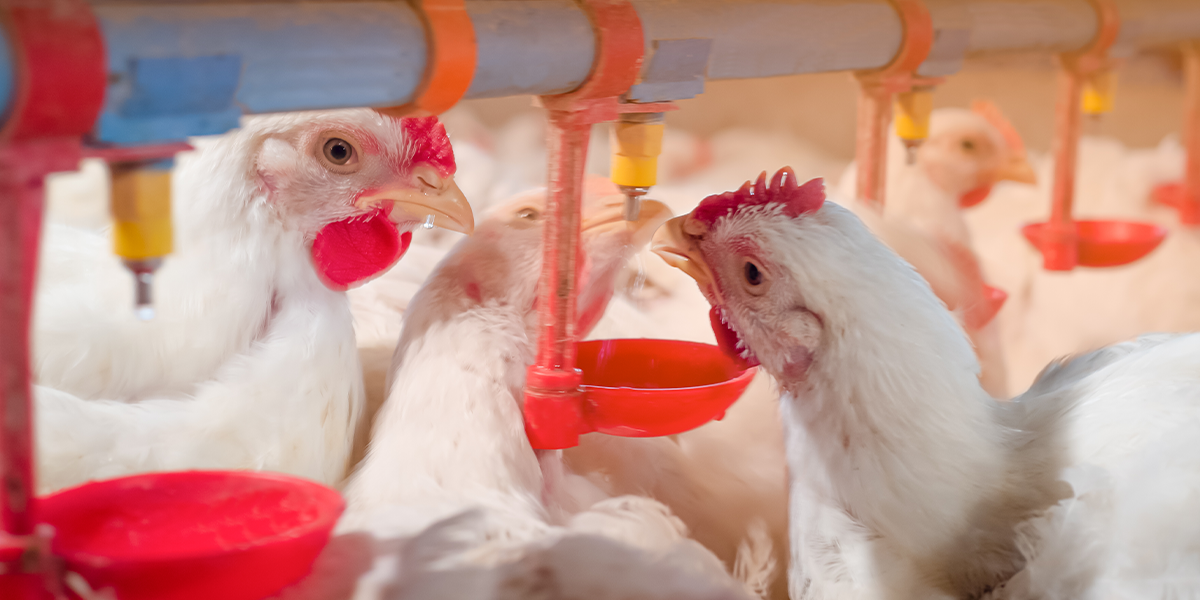Les oiseaux peuvent encore être moins performants, même lorsque les analyses standard de l'eau indiquent une qualité acceptable. Cela peut être dû aux interactions entre l'eau et l'alimentation, avant et après l'ingestion. Pour y remédier, Zinpro a développé le Zinpro® H2O Water Analysis Program™, une approche étape par étape pour aider les producteurs de volailles à atteindre une qualité d'eau optimale.
L'eau est le deuxième nutriment le plus vital pour les volailles, après l'oxygène. En moyenne, les volailles consomment environ une tasse d'eau par jour (plus de 200 millilitres), la consommation augmentant considérablement pendant les périodes de stress thermique.
Un apport adéquat en eau permet d'assurer des fonctions essentielles telles que :
- Digestion
- Métabolisme
- Absorption des nutriments
- Circulation sanguine
- Hydratation des tissus.
Variation des minéraux dans les sources d'eau
Bien que nous connaissions l'importance d'une eau potable propre, fraîche et de haute qualité pour les volailles, la définition d'une eau potable de bonne qualité reste un défi. En effet, la qualité de l'eau peut varier en fonction des périodes de pluie et du type de source d'eau utilisée par l'agriculteur. En général, les puits profonds ont tendance à avoir une meilleure qualité microbiologique de l'eau mais une teneur en minéraux plus élevée. En revanche, les sources d'eau superficielles ont généralement une teneur en minéraux plus faible, mais sont plus susceptibles d'être contaminées. Les précipitations peuvent avoir un impact supplémentaire sur ces sources ; elles peuvent diluer la teneur en minéraux dans les puits profonds tout en augmentant les niveaux de minéraux et de contaminants dans les sources superficielles en raison du lessivage.
La présence en trop grande quantité de certains minéraux dans l'eau potable peut être dangereuse. Des seuils de toxicité ont été établis pour le mercure et le plomb. Pour les minéraux tels que le fer, le manganèse, le cuivre et le magnésium, des niveaux supérieurs aux limites recommandées ne sont pas nécessairement toxiques mais peuvent altérer le goût et l'odeur de l'eau, interagir avec d'autres minéraux ou nutriments, réduire l'apport, l'absorption des minéraux et, en fin de compte, affecter les performances des oiseaux. Les analyses d'eau de ferme effectuées par Zinpro montrent que le fer et le manganèse dépassent souvent les niveaux acceptables.
Les minéraux peuvent interagir avec les nutriments
Il est important de tenir compte du fait que certains composants (tels que les minéraux) présents dans l'eau peuvent interagir négativement avec les nutriments contenus dans les aliments. Le fait de négliger ces interactions, ou de ne pas disposer des données et des connaissances nécessaires pour y répondre, peut affecter de manière significative la santé, les performances et l'efficacité de la production des oiseaux.
Un exemple concret est l'enzyme phytase, un ingrédient standard dans les régimes alimentaires commerciaux pour volailles afin d'augmenter la digestibilité des aliments. Des niveaux élevés de minéraux dans l'eau peuvent entraver l'activité de la phytase, réduisant ainsi l'efficacité de l'alimentation. On sait qu'une teneur élevée en fer favorise la croissance de bactéries intestinales nocives telles que le Salmonella et E. coliperturbant le microbiome et provoquant des problèmes digestifs. En outre, certains minéraux de l'eau peuvent interférer avec la fonction de liant des mycotoxines dans les aliments pour animaux.
Le programme d'analyse de l'eau Zinpro H2O
Pour maintenir une santé optimale du troupeau, il est recommandé de mettre en œuvre un programme de gestion de l'eau dans l'exploitation avicole. Les producteurs de volailles testent leur approvisionnement en eau deux fois par an : une fois au printemps pour savoir quelles améliorations doivent être apportées, et une autre fois à l'automne pour pouvoir comparer les résultats et identifier les besoins d'amélioration supplémentaires.
Le programme Zinpro® H2O Water Analysis Program™ analyse les résultats de votre analyse d'eau et les compare aux normes de qualité de l'eau établies pour aider les nutritionnistes, les producteurs et les vétérinaires à identifier les sujets de préoccupation et à examiner les signes de problèmes potentiels liés à l'eau. Sur la base des résultats de votre analyse d'eau, nous vous fournissons une analyse complète, avec la possibilité de choisir parmi plus de 40 composants de l'eau et 18 minéraux alimentaires.
L'analyse de l'eau et les résultats du programme d'analyse de l'eau Zinpro H2O peuvent contribuer à réduire les maladies et les infections et à améliorer les performances de production de votre élevage de bétail et de volaille.
Pour en savoir plus sur laProgramme d'analyse de l'eau Zinpro H2OContactez un représentant Zinpro dès aujourd'hui.

